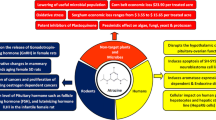Abstract.
A luminescent bacterial biosensor was used to quantify bioavailable arsenic in artificial groundwater. Its light production above the background emission was proportional to the arsenite concentration in the toxicologically relevant range of 0 to 0.5 µM. Effects of the inorganic solutes phosphate, Fe(II) and silicate on the biosensor signal were studied. Phosphate at a concentration of 0.25 g L−1 phosphate slightly stimulated the light emission, but much less than toxicologically relevant concentrations of the much stronger inducer arsenite. No effect of phosphate was oberved in the presence of arsenite. Freshly prepared sodium silicate solution at a concentration of 10 mg L−1 Si reduced the arsenite-induced light production by roughly 37%, which can be explained by transient polymerization leading to sequestration of some arsenic. After three days of incubation, silicate did not have this effect anymore, probably because depolymerization occurred. In the presence of 0.4 mg L−1 Fe(II), the arsenite-induced light emission was reduced by up to 90%, probably due to iron oxidation followed by arsenite adsorption on the less soluble Fe(III) possibly along with some oxidation to the stronger adsorbing As(V). Addition of 100 µM EDTA was capable of releasing all arsenic from the precipitate and to transform it into the biologically measurable, dissolved state. The biosensor also proved valuable for monitoring the effectiveness of an arsenic removal procedure based on water filtration through a mixture of sand and iron granules.
Similar content being viewed by others
References
M Berg H C Tran T C Nguyen H V Pham R Schertenleib W Giger (2001) Environ Sci Technol 35 25
W H Yu C M Harvey C F Harvey (2003) Wat Resour Res 39 1146 Occurrence Handle10.1029/2002WR001327
M M Rahman D Mukherjee M K Sengupta U K Chowhudry D Lodh C R Chanda S Roy M Selim Q Quamrussaman A H Milton S H Shahidullah M T Rahman D Chakraborti (2002) Environ Sci Technol 36 5385 Occurrence Handle1:CAS:528:DC%2BD38XotlSmtbc%3D Occurrence Handle10.1021/es020591o
British Geological Survey, Arsenic Contamination of Groundwater in Bangladesh. BGS Technical Report WC/00/19; London, 2001
J Cai M S DuBow (1997) Biodegradation 8 105 Occurrence Handle1:CAS:528:DyaK2sXntlKqsbw%3D Occurrence Handle10.1023/A:1008281028594
S Tauriainen M Virta W Chang M Karp (1999) Anal Biochem 272 191 Occurrence Handle1:CAS:528:DyaK1MXksFantLs%3D Occurrence Handle10.1006/abio.1999.4193
F F Roberto J M Barnes D F Bruhn (2002) Talanta 58 181 Occurrence Handle1:CAS:528:DC%2BD38XlvVGns7c%3D Occurrence Handle10.1016/S0039-9140(02)00266-7
J Stocker D Balluch M Gsell H Harms J Feliciano S Daunert K A Malik J R van der Meer (2003) Environ Sci Technol 37 4743 Occurrence Handle1:CAS:528:DC%2BD3sXnt1Orsbc%3D Occurrence Handle10.1021/es034258b
R Turpeinen M Virta M M Haggblom (2003) Environ Toxicol Chem 22 1 Occurrence Handle1:CAS:528:DC%2BD38XpslCmsLo%3D Occurrence Handle10.1897/1551-5028(2003)022<0001:AOABIC>2.0.CO;2
C Djerassi (2004) Angew Chem Int Ed 43 2330 Occurrence Handle1:CAS:528:DC%2BD2cXktFShtLs%3D Occurrence Handle10.1002/anie.200330079
L C Roberts S J Hug T Ruettimann M Billah A W Khan M T Rahman (2004) Environ Sci Technol 38 307 Occurrence Handle1:CAS:528:DC%2BD3sXovFOgs7c%3D Occurrence Handle10.1021/es0343205
S J Hug L Canonica M Wegelin D Gechter U von Gunten (2001) Environ Sci Technol 35 2114 Occurrence Handle1:CAS:528:DC%2BD3MXitlyrs78%3D Occurrence Handle10.1021/es001551s
S J Hug O Leupin (2003) Environ Sci Technol 37 2742 Occurrence Handle10.1021/es026208x
D K Nordstrom (2002) Science 296 2143 Occurrence Handle1:CAS:528:DC%2BD38XkvFGhs7o%3D Occurrence Handle10.1126/science.1072375
G R Willsky M H Malamy (1980) J Bacteriol 144 366 Occurrence Handle1:CAS:528:DyaL3cXmtlWlsLY%3D
Stumm W, Morgan J J (1996) Aquatic chemistry, chemical equilibria and rates in natural waters, 3rd edn. John Wiley & Sons, New York
J Nriagu M J Kim (2000) Sci Total Environ 247 71 Occurrence Handle10.1016/S0048-9697(99)00470-2
B Nowack L Sigg (1997) Geochim Cosmochim Acta 61 951 Occurrence Handle1:CAS:528:DyaK2sXhvVGksLo%3D Occurrence Handle10.1016/S0016-7037(96)00391-2
S Ramanathan W P Shi B P Rosen S Daunert (1997) Anal Chem 69 3380 Occurrence Handle1:CAS:528:DyaK2sXkslKhs7o%3D Occurrence Handle10.1021/ac970111p
Author information
Authors and Affiliations
Corresponding author
Rights and permissions
About this article
Cite this article
Harms, H., Rime, J., Leupin, O. et al. Effect of Groundwater Composition on Arsenic Detection by Bacterial Biosensors. Microchim Acta 151, 217–222 (2005). https://doi.org/10.1007/s00604-005-0402-z
Received:
Accepted:
Published:
Issue Date:
DOI: https://doi.org/10.1007/s00604-005-0402-z




